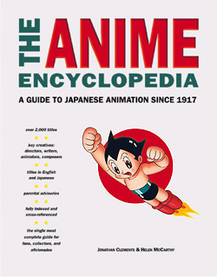Review
by George PhillipsThe Anime Encyclopedia
A Guide to Japanese Animation since 1917
By Jonathan Clements & Helen McCarthy
| Review: | |||||||||
While anime in its modern form has only been around for approximately the last 40 years, animation in Japan extends back over twice as long, as this work proves. In the early days of anime, independent animators worked vigorously to produce what eventually would pave the way to Astro Boy in 1963. In the 1980s, a boom of independent studios and a dramatic influx of money produced some of the most diverse anime series ever.
The Anime Encyclopedia includes information about animation in Japan dating back to 1917, with pictures from productions as early as 1924. The bulk of information concerns titles from 1979 onward, but many earlier anime series also grace the pages of the Encyclopedia.
Each entry contains a listing for the Japanese title (JPN), alternative English titles (AKA), and the format of the series (OVA, TV series, movie, special, etc). The director (DIR), Story Writers (SCR), Animators (ANI), Music Composers (MUS) and Production Staff and Studios (PRD) are also listed. In Little Ghosts, the Designer (DES) was not credited in the production, and could not be found elsewhere. Each entry has a short summary of the series, occasionally including additional specifics about the manga, international releases, the director's other works, or other tidbits of information. The average summary runs for one or two paragraphs, briefly describing the story of the series, and its influences. Of course, important titles in anime history include much longer summaries with more detailed information. These write-ups usually include information that is common knowledge about each series, but occasionally delve into less-known facets of the production. Littered throughout the Encyclopedia are pictures of various anime series and films, the most amazing of which is from the earliest known anime production, Mukuzo Imokawa the Doorman. Pictures from War-time animated productions, such as Aerial Ace and Black Cat Banzai, are also included. Although these titles look nothing like modern anime, they provide a framework of how anime has evolved over the years. The Anime Encyclopedia proudly states that "1979 was [their] watershed year; most titles released after that date were marked for inclusion". While a diligent reader may find a few series missing in the Encyclopedia after 1979 (such as Tatsunoko's Mori no Youki na Kobito-tachi Berufii to Rirubitto, AKA: "Lil' Bits") only laborious searching will uncover a missing title. The thoroughness of The Anime Encyclopedia is impressive, including information about many shows with little or no prior English information available. The Anime Encyclopedia is an excellent desktop reference for both the avid fan and the casual anime viewer! I highly recommend this work to anyone interested in learning more about the vast history of anime, but isn't sure where to begin. |
|||||||||
|
The views and opinions expressed in this article are solely those of the author(s) and do not necessarily represent the views of Anime News Network, its employees, owners, or sponsors.
|
| Grade: | |||
|
+ In-depth analysis of several major series, and discussions on hundreds of anime series rarely (if ever) heard of in the West. |
|||
